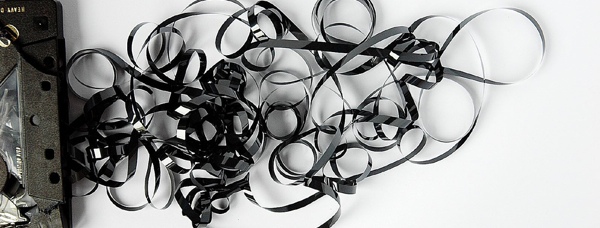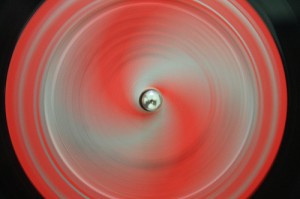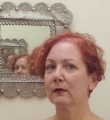You have no items in your cart. Want to get some nice things?
Go shopping
My favorite uncle and aunt moved to Zurich when I was six. It was too expensive to call, so we got tape recorders and mailed cassettes back and forth. Each one was a variety show of our lives: I sang, my mother played the piano, we recorded Star Trek and Creature Features and told stories. Before Facebook and email and discount airlines, Europe was still a world away.
My family was always recording itself. Before I was born, my grandfather had a 78 recorder with bright red licorice-colored LPs. They captured a time and people long gone: Kid Morris, my great-grandfather, who was a boxer and a butcher and came from Hungary; and Mattie Staley, housekeeper and a legendary cook, who gave a tour of “her” kitchen.
But the year I was eight, my grandparents sold the house on Chestnut Drive, and gave away anything they couldn’t sell. For years, I longed for those tapes from Europe, a visit to a lost childhood. I gently unfold airmail from 1970.
The Matterhorn is the most famous mountain in Switzerland. In Disneyland there is a small copy of the Matterhorn, and special “mountain” climbers climb it every hour. We have enclosed some Viewmaster pictures for you. We hope you enjoy them.
Aunt Barbara praises my recorder playing on the last cassette we sent. Uncle Jim notes he’s printing because I haven’t learned to read cursive yet.
On a separate sheet marked “Dear Everyone Else,” he mentions a Swissair flight bound for Tel Aviv that was blown up in flight, killing everyone on board.
Soon it will be as dangerous to live in Switzerland as it is to walk out at night in New York City.
Recently I discovered Uncle Jim still has three of our old tapes stashed away in a drawer. He doesn’t have a cassette player though. I pack them, offering to find a transfer house and digitize them.
My only working cassette player is in the car, so I drive around San Francisco in an old red Honda and time-travel. But these tapes aren’t recordings of me—they’re ones Uncle Jim and Aunt Barbara recorded for their parents. They’re 26 and 27, in London for the first time, visiting Carnaby Street and Buckingham Palace and restaurants with rude immigrant waiters. Once I get over the initial disappointment, I’m hooked.
“Those guards. What are they called?”
“Beefeaters.”
“They wear these wild costumes. You go places, and everyone’s in costume. This is what makes traveling so exciting….But after a while, you get tired of hearing of 8000 people who lost their heads.”
Although they graduated in the 60s, they are decidedly not hippies. Uncle Jim describes tie-dye as paint thrown on a shirt. They get balcony seats to Hair, and Uncle Jim wants to dance on stage at the end when everyone takes their clothes off, but Aunt Barbara is put off by the show’s crudeness.
At times, their language is quaint. After living in New England, my uncle is thrilled by London’s cultural diversity, how many “orientals” and Africans (vs. “American negroes”) there are. My aunt bears a trace of a Rochester accent. It reminds me of Jackie Kennedy’s tour of the White House, soft and cultivated even as she’s describing unwanted attention in Rome.
The men are incredible, the way they stare at you. I felt forever under the gaze of someone. They look you up and down, from the tip of your head to the tip of your toes. You’d walk by, and their heads would turn. It was flattering, but after a while, I wanted to poke their eyeballs out.
They are perhaps the first travelers ever to eat terribly in Italy, the result of an American Express tour with prepaid dinners at the Piccadilly Cafeteria. Between Easter week and strikes, many museums are closed. They do manage to see the Pieta.
Michelangelo, who was only 27 and had just lost his mother, portrayed Mary as very young, hardly any older than Jesus.
Madrid, where they rely on a Fielding guidebook and splurge on lobster at the Ritz, fares better. But they quickly tire of religious art at the Prado.
Jesus Christ was everywhere to be seen, with blood gushing from a wound under his left arm. When you’ve seen one Jesus Christ, you’ve seen ’em all.
Madrid’s traffic and pollution overwhelm my aunt, “the seas of people like ants, marching ants.” It doesn’t help that she brought the wrong shoes or that Jim wants to save a few pesetas and take the crowded subway.
Every night washing my face, the white cotton was pitch black from my pores. I’d use new pieces and new pieces to get the dirt off….I’ll be part Madrid till the day I die.
After 18 months abroad, Uncle Jim has borrowed a second cassette recorder and daisy-chained it to make tapes for his parents and Barbara’s at the same time. The intimate mood shifts to more of a performance. They have a routine.

The tapes are a stand-in for a weekly phone call or visit to their parents, listened to once, flipped over, and recorded right on top of. It’s a wonder any of them survived to the next generation.
After my uncle and aunt came back from Europe, we’d visit them in New York. On a hot Saturday night, my uncle would set up a projector in the living room, and we’d watch our family history, silent films in which we were the stars.
The movies begin right after the war, as my grandparents prospered and moved from Brooklyn to the suburbs, showing off an ever-nicer series of coats and cars. My great-grandparents were the first members of the family to fly to Florida, and everyone went to see them off at the airport. There’s an 8mm reel of me as a toddler playing in the yard. Chico the German shepherd puppy darts into the frame to lick my face and momentarily takes my waving hand in his mouth.
These scenes speak to an earlier time when we were all together, intact. An idealized narrative that perhaps only exists in our memories, and in these recordings, but is somehow essential to who we are.
In the 80s, concerned about the films deteriorating from the humidity in Uncle Jim’s basement, my mother spent a night videotaping a projection as she and my grandmother narrated.
They identify neighbors, dogs, babies, distant cousins.
On screen, a slender 19-year-old—my mother!—hits a tennis ball and then smiles for the camera.
“Look how skinny I was!”
“You must have been going to that diet doctor….Oh, are we recording?”
I have that videotape, although not a VCR to play it back on. A shelf in my hall closet is devoted to albums from the analog 20th century, among them postcards and aerogrammes from my first trip to Switzerland, Italy and London when I was 20. I also have a box filled with floppy disks and Zip cartridges. Twenty years from now, no one will ever know what was on them.
Listening to voices on tape is different from watching ourselves on screen. We didn’t think about how we looked when we made a tape so we were less self-conscious, less inhibited. (I’d be more enthusiastic to Skype with my mom if my grandmother hadn’t spent my childhood fussing over my hair.)
I order a USB cassette deck to transfer the tapes to the latest medium, so we can visit 1969 on our smartphones. I’m looking forward to sharing them with the next generation, my cousins, Jim and Barbara’s children, who never knew their parents as young married 20-somethings.
As I research conversion tools online, I run across a review by a woman who converted old answering machine tapes.
It was a blessing to be able to hear the voice of my husband and mother and a short message from a dear friend who had also passed away. I gave a 3 star review because of the manual and the flimsiness of the machine, but it was worth 10 stars to be able to hear these old messages.
Perhaps all this transferring and archiving is futile. It’s only a matter of time until the latest format becomes obsolete, unreadable, until we too are forgotten. But hearing my aunt and uncle giggle over sleeping in bunk beds at a ski hostel in the Alps, I close my eyes and glimpse my six-year-old self again. And then she’s gone.

About Diana J. Wynne
Diana J. Wynne believes the best stories are true. Her essays on travel, politics, and identity have appeared in Salon, The New York Times, Mississippi Review, The Raw Story, Ms. Magazine, and Pure Slush. Make her an offer.




I absolutely loved the experience of reading this, Diana — in part, because of your writing and the completely involving story (and meta story) you weave back and forth through time. Much as a voice recording keeps the speakers less self-conscious, these snatches of audio transcriptions without picture gave just fodder for my imagination to call up compelling portraits of a family I will never meet.
But I also enjoyed this piece because of what it shook loose from my own outdated recording device (my mind). I frequently had to stop and look away as I remembered parallel experiences of my own. I was an exchange student in Sweden for a year and was allowed one telephone call over the course of that year. So instead, I made cassette tapes for my parents and my closest friends. It was mostly stories, an occasional example of the Swedish I was learning, and, as I was trying to teach myself piano, the odd snippet or two of that thrown in. I’d skip school and spend most of a day producing that month’s edition of my travelogue. Thinking back I’m not sure if I’m horrified or fascinated by what I would find were I to revisit these unintended time capsules…
Anyway, you have me meditating on time and distance, how both aging and technology conspire to make what was once rather ordinary to be precious today, and what was once immersive to be, at best, ephemeral. Now I must find these tapes.
You must find them. One of the best parts of this story is how many people have shared their own family histories: love letters to and from Vietnam, drawings and cassettes mailed “round robin” to cousins, boxes of old VHS tapes from when we were kids.
Oh just gorgeous … Diana at her best, digging in deep but in such an effortless and direct way. Brava! I loved reading this.
Thank you, Matt. That means a lot coming from you.
Diana, what a lovely, thoughtful essay. And what a fascinating family!
Thanks Lisa. Endless material : )